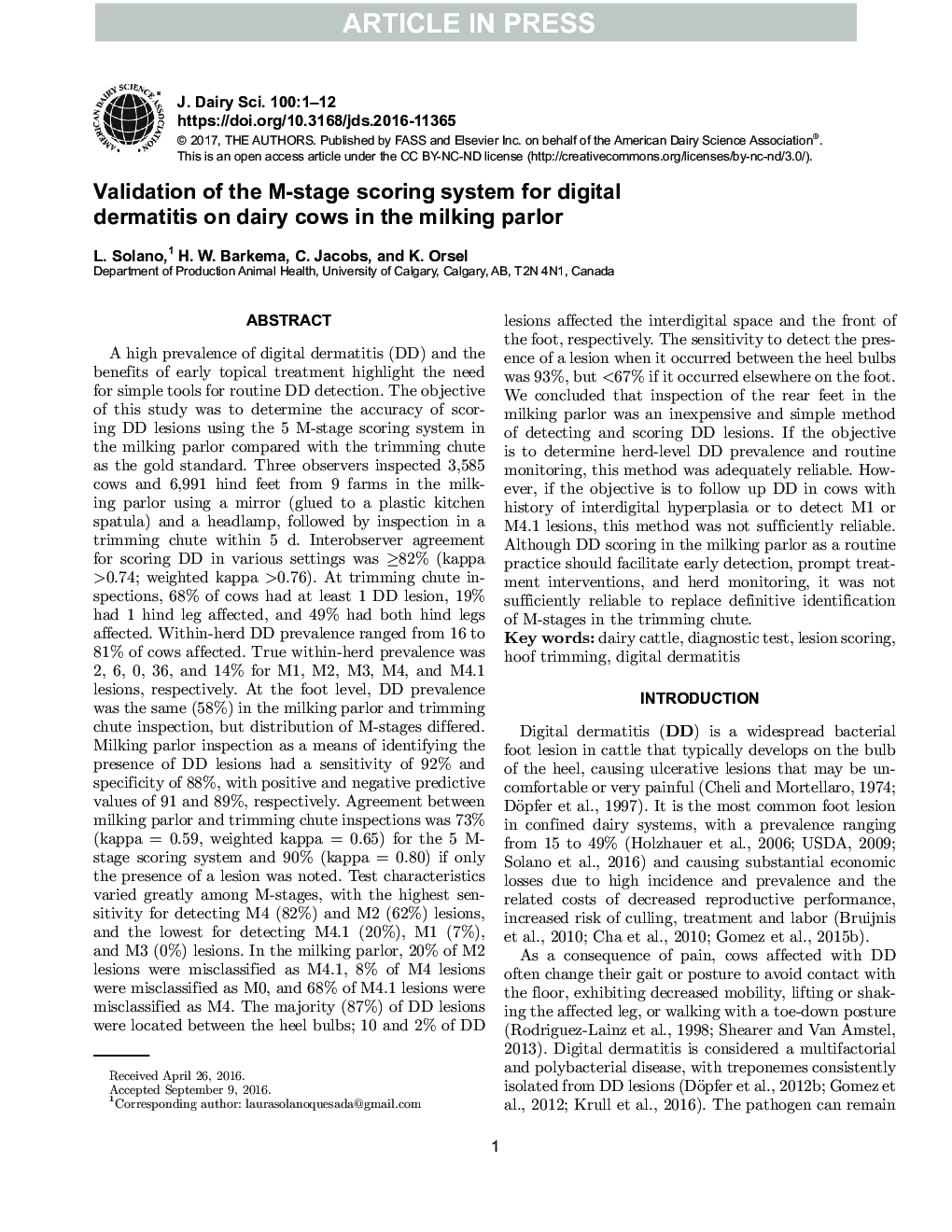| کد مقاله | کد نشریه | سال انتشار | مقاله انگلیسی | نسخه تمام متن |
|---|---|---|---|---|
| 5542464 | 1402518 | 2017 | 12 صفحه PDF | دانلود رایگان |
عنوان انگلیسی مقاله ISI
Validation of the M-stage scoring system for digital dermatitis on dairy cows in the milking parlor
دانلود مقاله + سفارش ترجمه
دانلود مقاله ISI انگلیسی
رایگان برای ایرانیان
کلمات کلیدی
موضوعات مرتبط
علوم زیستی و بیوفناوری
علوم کشاورزی و بیولوژیک
علوم دامی و جانورشناسی
پیش نمایش صفحه اول مقاله

چکیده انگلیسی
A high prevalence of digital dermatitis (DD) and the benefits of early topical treatment highlight the need for simple tools for routine DD detection. The objective of this study was to determine the accuracy of scoring DD lesions using the 5 M-stage scoring system in the milking parlor compared with the trimming chute as the gold standard. Three observers inspected 3,585 cows and 6,991 hind feet from 9 farms in the milking parlor using a mirror (glued to a plastic kitchen spatula) and a headlamp, followed by inspection in a trimming chute within 5 d. Interobserver agreement for scoring DD in various settings was â¥82% (kappa >0.74; weighted kappa >0.76). At trimming chute inspections, 68% of cows had at least 1 DD lesion, 19% had 1 hind leg affected, and 49% had both hind legs affected. Within-herd DD prevalence ranged from 16 to 81% of cows affected. True within-herd prevalence was 2, 6, 0, 36, and 14% for M1, M2, M3, M4, and M4.1 lesions, respectively. At the foot level, DD prevalence was the same (58%) in the milking parlor and trimming chute inspection, but distribution of M-stages differed. Milking parlor inspection as a means of identifying the presence of DD lesions had a sensitivity of 92% and specificity of 88%, with positive and negative predictive values of 91 and 89%, respectively. Agreement between milking parlor and trimming chute inspections was 73% (kappa = 0.59, weighted kappa = 0.65) for the 5 M-stage scoring system and 90% (kappa = 0.80) if only the presence of a lesion was noted. Test characteristics varied greatly among M-stages, with the highest sensitivity for detecting M4 (82%) and M2 (62%) lesions, and the lowest for detecting M4.1 (20%), M1 (7%), and M3 (0%) lesions. In the milking parlor, 20% of M2 lesions were misclassified as M4.1, 8% of M4 lesions were misclassified as M0, and 68% of M4.1 lesions were misclassified as M4. The majority (87%) of DD lesions were located between the heel bulbs; 10 and 2% of DD lesions affected the interdigital space and the front of the foot, respectively. The sensitivity to detect the presence of a lesion when it occurred between the heel bulbs was 93%, but <67% if it occurred elsewhere on the foot. We concluded that inspection of the rear feet in the milking parlor was an inexpensive and simple method of detecting and scoring DD lesions. If the objective is to determine herd-level DD prevalence and routine monitoring, this method was adequately reliable. However, if the objective is to follow up DD in cows with history of interdigital hyperplasia or to detect M1 or M4.1 lesions, this method was not sufficiently reliable. Although DD scoring in the milking parlor as a routine practice should facilitate early detection, prompt treatment interventions, and herd monitoring, it was not sufficiently reliable to replace definitive identification of M-stages in the trimming chute.
ناشر
Database: Elsevier - ScienceDirect (ساینس دایرکت)
Journal: Journal of Dairy Science - Volume 100, Issue 2, February 2017, Pages 1592-1603
Journal: Journal of Dairy Science - Volume 100, Issue 2, February 2017, Pages 1592-1603
نویسندگان
L. Solano, H.W. Barkema, C. Jacobs, K. Orsel,